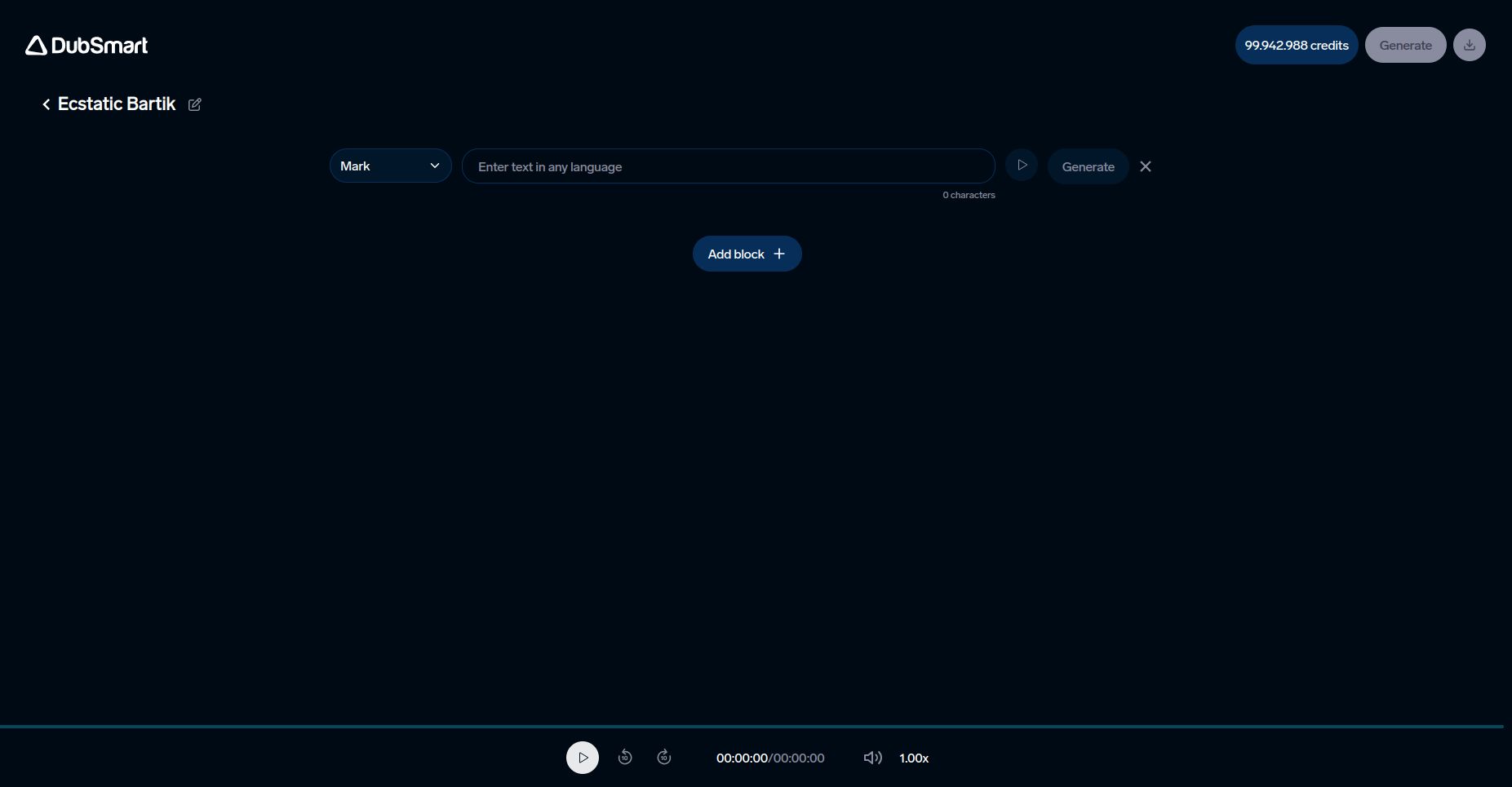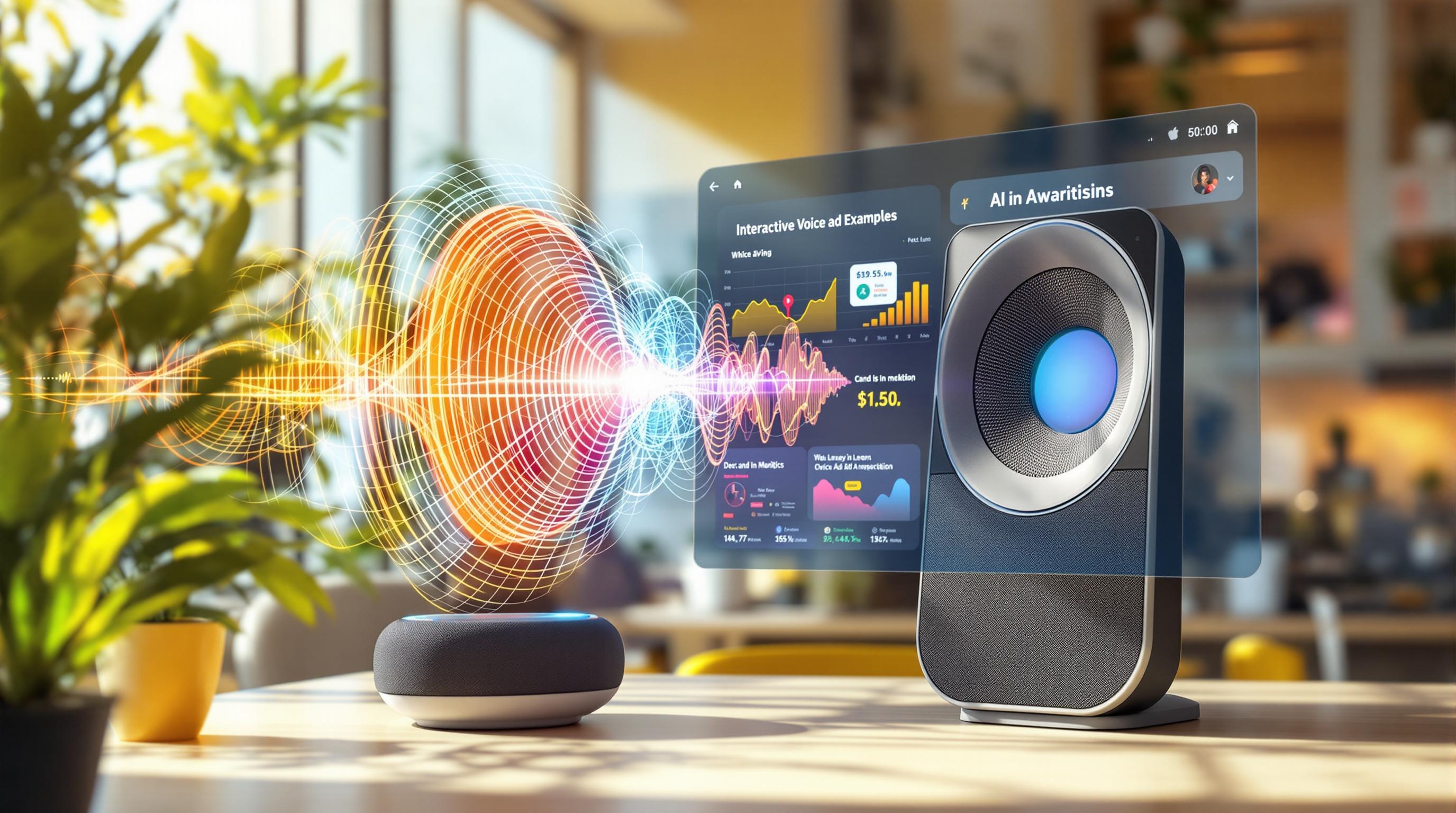Interactive Voice Ads: How AI Changes Marketing
Interactive voice ads are transforming how brands connect with audiences by enabling two-way conversations powered by AI. Here's what you need to know:
- What They Are: Ads that use AI to interact with users in real time, personalizing responses based on spoken input.
- Why They Matter: They boost engagement, provide real-time personalization, and collect valuable data. For example, 72% of users found them easy to engage with during Pandora's testing.
- AI's Role: AI helps create tailored ads, enables instant responses, and reduces production costs by automating tasks like voiceovers.
- Key Use Cases: From product promotions (e.g., Doritos) to automotive campaigns (e.g., Volkswagen), interactive voice ads are effective across industries.
- Tools to Use: Platforms like Instreamatic (real-time interaction), DubSmart (multilingual support), and Wondercraft.ai (personalized content) make creating these ads easier.
These ads are reshaping marketing by making it more interactive, cost-efficient, and globally accessible. Ready to dive deeper? Let’s explore the details.
How AI Drives Interactive Voice Ads
Creating Personalized Ads
AI is changing the game in voice advertising by making it more tailored to individual listeners. Thanks to voice recognition and audience targeting, AI can analyze data like user demographics and interaction history to design ads that feel personal. For instance, Instreamatic's voice ads adjust their messaging based on how users respond, delivering a more customized experience.
This strategy has proven effective. Take Mazda’s campaign as an example: it used AI-powered voice interactions to engage listeners, managing to sway 3.29% of initially uninterested users.
Real-Time User Interaction
Interactive voice ads get their dynamic and conversational edge from AI's ability to process and respond instantly. Much like Amazon Alexa, these ads can understand verbal feedback and reply in real time. This instant interaction helps users feel acknowledged and engaged.
By enabling smooth, natural conversations, AI allows brands to connect with consumers in a more meaningful way. Responses are tailored to user input, keeping the interaction relevant. Platforms like Pandora have already tested this method with brands such as Doritos, Nestle, and Turner Broadcasting, proving how effective real-time voice interactions can be in advertising.
Cutting Costs and Boosting Efficiency
AI also makes creating voice ads faster and more affordable. Traditional methods rely on studio time, voice actors, and post-production, but platforms like Wondercraft.ai allow agencies to produce professional-grade audio ads without those extra expenses.
AI speeds up production by generating high-quality voiceovers in minutes, removing the need for studios or voice talent. This makes voice advertising accessible for businesses of all sizes, not just big brands. It also supports quick testing and fine-tuning of ads, helping marketers pinpoint what works best using data.
These advancements make interactive voice ads a practical and scalable option for various marketing strategies.
Using Interactive Voice Ads in Marketing Campaigns
Top Use Cases for Voice Ads
Interactive voice ads shine in various marketing scenarios. For example, product promotions see great results when paired with voice interaction. Brands like Doritos and Nestle have successfully used these ads on streaming platforms to encourage immediate engagement. Customers can easily request details, redeem offers, or share feedback - all through a simple voice command.
The automotive industry has also embraced this approach. Take Volkswagen's award-winning campaign, which used interactive dialogue to boost brand awareness and guide users toward specific actions.
Breaking Language Barriers
AI-driven voice technology has transformed multilingual marketing. Tools like DubSmart allow campaigns to run in 33 languages using voice cloning. This combines real-time translation with natural-sounding speech, ensuring consistent branding across global markets.
These advancements enable marketers to create personalized experiences while connecting with diverse audiences. Beyond just language, pairing voice ads with other marketing channels can amplify their effectiveness even further.
Combining Voice Ads With Other Channels
When voice ads are integrated with other platforms, their impact grows exponentially. NBCUniversal, for instance, uses interactive voice ads alongside video content to create a more engaging experience for viewers.
By blending voice ads with social media, video, and mobile platforms, brands can maintain consistent messaging while leveraging the unique strengths of each channel. This multi-platform strategy enhances the AI-driven personalization that makes voice ads so effective.
While these tactics can unlock the potential of interactive voice ads, the key lies in creating ads that truly connect with the audience.
sbb-itb-f4517a0
Tips for Creating Effective Voice Ads
Using Natural-Sounding Voices
Natural voices grab attention and keep listeners engaged. A study by Pandora found that 72% of users preferred ads with realistic voices. When selecting AI-generated voices, aim for ones that fit your brand and audience. Prioritize conversational tones that feel relatable. Modern AI tools now mimic human speech patterns with impressive accuracy, making this easier than ever.
Being Transparent and Ethical
Honesty matters. Let your audience know when AI is involved in your ads to build trust and meet FTC guidelines. Always get user consent for voice interactions, double-check your content for accuracy, and ensure you have proper licenses for the voice technology you use. Protecting privacy and maintaining credibility are non-negotiable. As AI evolves, ethical practices should remain at the core of your strategy.
Preparing for AI Advancements
The voice ad space is growing fast, driven by AI's progress. Keep up by monitoring new developments and adjusting your campaigns based on performance data like say-through rates and engagement. For instance, Pandora's interactive voice ads saw a 47% positive response rate, proving their effectiveness. Platforms like Wondercraft.ai can simplify ad production while ensuring high-quality output.
Tools for Creating AI-Powered Voice Ads
Marketers looking to dive into AI-powered voice ads have a range of tools at their disposal to simplify production and improve audience interaction.
Using DubSmart

DubSmart provides features like video dubbing, text-to-speech, and voice cloning in 33 languages. These tools help brands maintain consistency across global markets. With flexible pricing plans, DubSmart caters to both small-scale campaigns and large enterprise projects, offering tailored support when needed.
Other AI Platforms to Consider
While DubSmart is great for multilingual campaigns, other platforms bring unique strengths to voice advertising. Instreamatic specializes in creating interactive voice ads, allowing real-time conversations between brands and listeners. Wondercraft.ai, on the other hand, focuses on crafting personalized content that connects with specific audience groups.
Here's a quick comparison of these platforms:
| Platform | Specialty | Best For |
|---|---|---|
| DubSmart | Multilingual solutions | Global campaigns |
| Instreamatic | Interactive dialogue | Real-time engagement |
| Wondercraft.ai | Personalized content | Targeted messaging |
These tools highlight how AI is reshaping voice advertising. For example, Wondercraft.ai has been used to design highly focused campaigns with impressive engagement rates. In one case, Mazda leveraged AI-powered voice dialogue to convert 3.29% of initially uninterested listeners into active participants.
Conclusion
Summary of Key Points
AI-powered voice ads are transforming marketing by delivering a new level of personalization and audience connection. These tools have slashed production costs by removing the need for traditional studio recordings and allowing quick content updates. With features like multilingual support from tools such as DubSmart, brands can now easily run global campaigns. These advancements, paired with ongoing progress in AI, signal a promising future for voice-based advertising.
The Future of Voice Ads
The voice advertising industry is poised for strong growth, fueled by increasing consumer interest in audio and video content and continuous AI development. Here's how AI is shaping the future:
| Feature | Current Use | Future Possibilities |
|---|---|---|
| Real-time Interaction | Responds dynamically to user input | Predicts user needs based on past behavior |
| Voice Personalization | Targets basic demographics | Tailors ads to match user voice styles and preferences |
| Content Creation | Automates translations | Generates content instantly in real-time |
"AI-powered voice ads will continue to grow in popularity and become a key component of marketing strategies, with advancements in AI technology enabling more sophisticated and effective ad campaigns".
Platforms like Spotify show how AI-driven personalization can boost engagement in audio-focused environments. Their success highlights how tailored voice technology can elevate user experiences.
Looking ahead, voice ads need to balance personalization with ethical considerations, privacy, and user comfort. Combining AI voice tools with other marketing channels will create immersive campaigns, making voice ads an indispensable part of modern marketing strategies.
